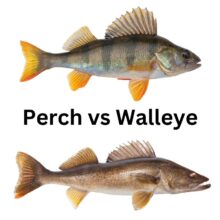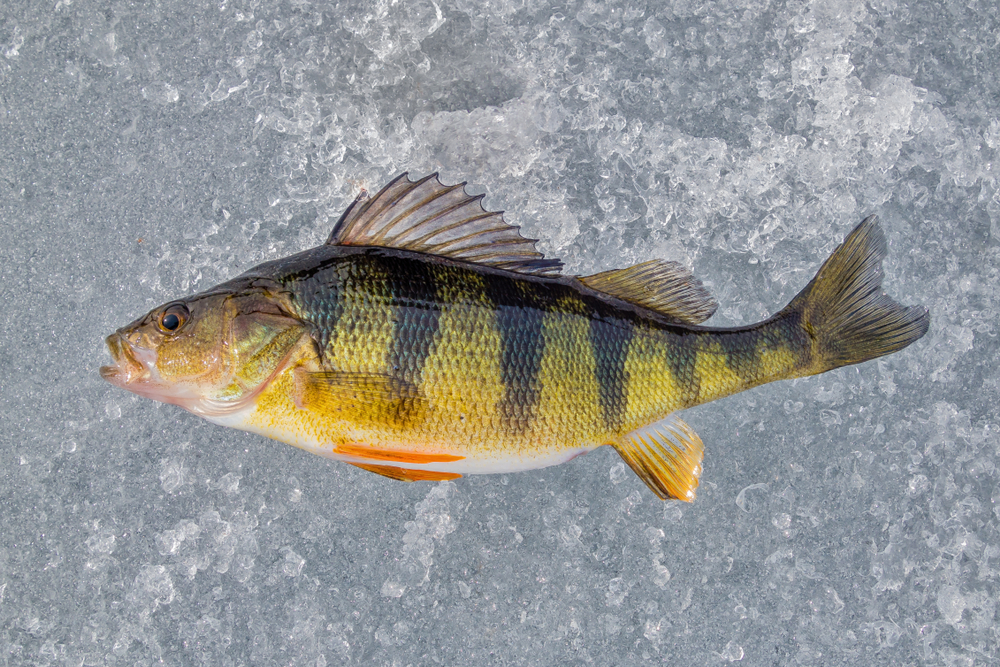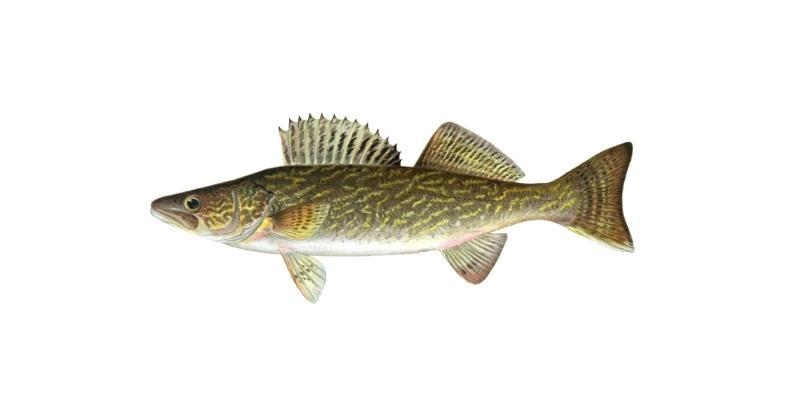This article may contain affiliate links. If you make a purchase after clicking on a link we may earn a small commission at no extra cost to you. As an Amazon Associate, I earn from qualifying purchases.
Perch vs Walleye – What’s the Difference?

When perch and walleye are very small, they often share many similarities that might cause some anglers to mistake one species for the other.
Walleye do belong to the same scientific family category as perch, but these two fish have lots of differences that you’ll need to know if you want to be able to tell the difference between perch and walleye.
In this article, we’ll discuss these two fish species in greater detail and cover some of the main differences when it comes to perch vs walleye.
Perch vs Walleye Overview
Walleye and perch are actually part of the Perch family, which is scientifically titled the Percidae family. Some of the other fish species that belong to this family include sauger, perch, walleye and many other distinct species like darter fish and others. Many of these fish have the same basic body shape with similar large dorsal fins, as well as tail fins.
When comparing perch and walleye, you will notice that the two types of fish have quite a few features in common. They both have a very similar elongated body shape, large spiked dorsal fins, as well as other features like their color pattern.
However, these two fish will start to become more and more different from one another once they grow to maturity.
It’s well-known among anglers that walleye can grow quite large and are often some of the bigger species of game fish that fishermen like to target—mostly for their sheer size. Perch, on the other hand, are much smaller than walleye when they reach their full size potential.
Aside from this difference, it’s understandable why so many people confuse perch for walleye when these fish are in the juvenile stage because they look incredibly similar.
Both perch and walleye live in freshwater lakes and rivers throughout North America. Perch are known to be one of the most highly-adaptive species of fish that are known to live in the continent, but different variations of perch are found all over the world.
The perch is a unique type of fish that is semi-anadromous, which means it’s capable of living in both freshwater and saltwater.
In the following sections, we’ll discuss each type of fish in more detail.
Perch Overview
The type of perch that looks most similar and is most likely to be confused with walleye is the yellow perch. This fish is said to be semi-anadromous because it’s capable of living in virtually any type of freshwater lake or river system, as well as brackish, saltwater areas of rivers that join the ocean.
When an angler mentions perch, specifically in the United States or Canada, they are almost always referring to the yellow perch species.

Perch are typically a smaller fish that many anglers target for their meat as they are considered to be good table fare. These fish typically don’t grow to the large sizes that walleye are capable of reaching, but perch are usually comparable to some of the other freshwater species like bluegill or crappie as far as their size.
You can find perch in the shallow sections of most river systems, ponds or large lakes and reservoirs. In most cases, they prefer to live in water that doesn’t have a strong current, which makes larger lakes and reservoirs a better environment.
Perch are more suited to living in clear freshwater areas where they feed on a number of different types of prey, including insects and other small fish.
Walleye Overview
Walleye are also found in most of the freshwater lakes and rivers across the upper half of America, as well as Canada. They are especially prevalent in the eastern half of both countries and many anglers consider them to be one of the most enjoyable freshwater fish species to target for a number of reasons.
Walleye are considered one of the better-tasting freshwater fish species in North America, but they are lots of fun to catch as well.
Much like perch, walleye don’t typically prefer to live in freshwater habitats that have a strong current. Large reservoirs or lakes are much more suitable and, since they grow to a larger size than perch, walleye will generally be found in the deeper sections of lakes.

It’s common to find walleye across parts of Europe and Asia, but there are some differences between North American walleye and their European counterparts.
Walleye derive their name due to the strange pearlescent appearance of their eye, which is a result of a special reflective layer of pigment called the tapetum lucidum. This highly-unique pigment helps walleye see in the dark and makes it much easier for them to detect prey in the deep, dark waters of most lakes and reservoirs.
They are considered to be one of the more popular freshwater fish across the northern United States and eastern Canada. Walleye are a very popular species for ice anglers, but are also incredibly fun to catch during the spring when they are engaged in their annual spawning preparation and shortly afterwards.
Perch and Walleye Size Differences
As we noted already, perch are quite a bit smaller than walleye and the main confusion between the two species comes from specimens that are in the juvenile stage of life. Perch are considered to be a smaller species of freshwater fish throughout North America.
The average size of a yellow perch is usually about 7 to 10 inches and most perch will weigh anywhere from 1.5 to 2 pounds in optimal conditions and with a solid diet. The world record yellow perch is a 4 pound, 3 ounce fish that was caught in New Jersey in 1865.
Walleye typically grow to be roughly 25 to 30 inches when they reach full maturity and often weigh about 10 to 15 pounds in the best of conditions. The world record walleye is listed as a 25 pound specimen that was caught in a Tennessee lake in 1960, yet there is much controversy surrounding this catch and its actual weight.
Perch and Walleye Differences
The major differences between perch and walleye are evident to most experienced anglers, but newcomers to the sport of fishing might not be able to tell these two apart so easily. The following identification points are things you can use to confidently tell the difference between perch and walleye.
Eyes
The most obvious and reliable method of telling the difference between perch or walleye is to examine the fish’s eyes. As we’ve already stated, a walleye’s eyes have a distinct appearance that makes the fish look like it’s staring blankly at no certain point.
Many years ago, a person who stared indistinctly was said to have been ‘walleyed’ and the fish was given the name ‘walleye’ due to this cloudy, opaque eye color and appearance.
A perch’s eye is very different and appears much like you would expect the eye of any other type of freshwater fish in North America to look like. The eye of the perch has a green or amber-colored iris and a solid-black pupil.
Stripes
The coloration and color pattern of perch and walleye appear very similar at first glance, but each type of fish has slight differences you’ll notice upon further inspection.
Perch are well-known for having very distinct stripes on the sides of their bodies. These stripes are vertically-aligned and are typically very distinct and defined compared to the yellowish-green color of the fish’s sides.
The stripes on a walleye are much less defined and these markings will fade with time as the fish becomes more green in color across its back and sides. However, when a walleye is still in the juvenile stage, it typically has vertically-aligned stripes that appear to be similar to the ones that are present on a perch.
You can tell these two types of fish apart by examining the darkness of the stripes compared to the fish’s overall coloration. A perch’s stripes will be very defined while a walleye’s stripes will be faint.
Belly Color
The third main way you can tell the difference between a perch and a walleye is to examine the color of the fish’s belly and pelvic fins. Perch, in most cases, will have an amber-colored belly and pelvic fins. This color might even appear to be bright orange, which is similar to the belly of a bluegill in many ways.
This yellow or orange coloration to the perch’s belly will usually become brighter and more vivid as the fish ages and matures, making fully-grown perch one of the more colorful specimens in North American freshwater lakes and rivers. A walleye’s belly will be white in contrast.
Conclusion
When viewing perch vs walleye side-by-side, it’s easy to see why so many anglers can become confused. However, with ample time on the water and enough fishing experience catching both species, you can use these different identification points and confidently be able to tell these two fish apart with relative ease.
